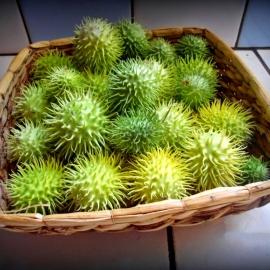 EXCLUSIVE
EXCLUSIVE






«Hedgehog» - Organic West Indian gourd Seeds (Cucumis anguria)
3.00 €
Cucumis anguria, commonly known as bur cucumber, bur gherkin, cackrey, gooseberry gourd, maroon cucumber, West Indian gherkin, and West Indian gourd, is a vine that is indigenous to Africa.
-
Organic West Indian gourd «Hedgehog»
Cucumis anguria, commonly known as bur cucumber, bur gherkin, cackrey, gooseberry gourd, maroon cucumber, West Indian gherkin, and West Indian gourd, is a vine that is indigenous to Africa.
It is similar and related to the common cucumber and its cultivars are known as gherkins. Cucumis anguria is a thinly stemmed, herbaceous vine scrambling up to 3 meters long. Fruits (45cm 34cm) are longly stalked, and ovoid to oblong. The surface of the fruits have long hairs covering a surface having warts and/or spines; the inner flesh is palid to green.
Also known as: Cucumis anguria, Cackrey, maroon cucumber, West Indian gherkin.
How to GrowThe plant is cultivated in the tropics and subtropics. It grows best in areas where annual daytime temperatures are within the range 21 - 28°c, but can tolerate 8 - 32°C. The plant cannot tolerate frost. It prefers a mean annual rainfall in the range 800 - 1,000mm, but tolerates 300 - 1,700mm. Requires a rich, well-drained moisture retentive soil and a warm very sunny position. Prefers a pH in the range 6 - 7.5, tolerating 5.5 - 8.3. It prefers warm, moderate humid conditions. It is sensitive to cold, susceptible to fungal diseases, and attacked by aphids and cucumber beetles. The plant is an invasive weed in parts of North America and in Australia, and a serious weed in peanut fields of the southern United States.
The fruits can be harvested 40 - 80 days from sowing the seed or planting out. There are two main forms of the plant, the wilder form that has a bitter taste and a cultivated form that is more or less free of the bitterness. There are many named varieties of the non-bitter form.
The plant is believed to be derived in cultivation from the tropical Brazilian species C. Longipes. Hook.
Edible Uses
Fruit - raw, cooked or pickled. The best forms have a very agreeable cucumber flavour without any bitterness. It can be used in salads or as part of a savoury dish. The fruit is frequently soaked in vinegar to make a pickle, it absorbs a large quantity of vinegar. The ovoid to oblong, yellow fruit is up to 5cm long and 4cm wide, produced on a long stalk.
Seed - raw. Rich in oil with a nutty flavour but very fiddly because it is rather small and covered with a fibrous seedcoat. Young leaves - cooked. In Africa the leaves of bitter forms are more likely to be eaten.
Medicinal
The seeds are vermifuge. They are ground into a fine flour, then made into an emulsion with water and eaten. It is then necessary to take a purge in order to expel the tapeworms or other parasites from the body.
The fruit is eaten to treat jaundice. Eating the fruits raw is believed to dissolve kidney stones. The juice of the fruit, mixed with oil, is applied to contusions. The fruit is applied to haemorrhoids. An enema of the wild plant is used to treat stomach pains.
The leaves, after being steeped in vinegar, are used against ringworm. A leaf juice preparation is applied to freckles. A decoction of the roots is used as a remedy for stomach troubles and to reduce oedema.
Other Uses
Bitter forms of the plant are sometimes used as a natural pesticide in stored crops. The juice of the fruit is reportedly used as an antifeedant in granaries.
